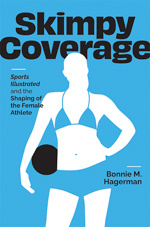Today, we are happy to bring you our conversation with Bonnie M. Hagerman, author of Skimpy Coverage: Sports Illustrated and the Shaping of the Female Athlete.
What inspired you to write this book?
I have been an athlete all of my life and an unwitting recipient of Title IX’s benefits. When my competitive career concluded and graduate studies beckoned, a focus on gender and sport was both natural and compelling. My decision to use Sports Illustrated as a lens was also a natural one. As a kid, issues of Sports Illustrated littered our den coffee table and were popular reading material in our sports-playing household. I knew that female athletes were underrepresented in Sports Illustrated, both in terms of the number of stories and the length of those stories, but I was curious about the female athletes SI did choose to cover.
What did you learn and what are you hoping readers will learn from your book?
I found that a number of the issues sportswomen have contended with since the 1950s remain challenges for sportswomen in the 2020s. This is particularly true when Bil Gilbert and Nancy Williamson highlighted a number of challenges facing female athletes in their 1973 three-part series on women and sport, including the ways in which female athletes were undervalued in terms of dollars spent on women’s amateur sport, dollars earned by professional sportswomen, the amount and type of media attention, and the importance of femininity at all times.
What surprised you the most in the process of writing your book?
The original goal of Skimpy Coverage had been to show how SI had actually offered its millions of readers a more diverse view of the female athlete in the 1950s and 1960s than it had in the 1980s and 1990s, and to show how, over time, the preferred female athlete was hard to distinguish from the magazine’s famed swimsuit issue models. Indeed, my focus on female athletes and swimsuit models in Sports Illustrated tightened when I discovered that those curious about my research on women in Sports Illustrated would inevitably remark, “Oh – you’re looking at swimsuit models?” The hopeful lilt in these comments made me consider the significance of the general assumption that a female in Sports Illustrated was not an athlete but a swimsuit model, as well as the possibility that the magazine wanted her to be seen that way.
What’s your favorite anecdote from your book?
That’s a hard question. In a book that spans almost 70 years of Sports Illustrated, it’s difficult to choose just one. Certainly Billie Jean King’s defeat of Bobby Riggs in the (second) Battle of the Sexes is a compelling (and popular) story. But I think equally important, if not moreso, is the role that “first Lady of U.S. Track” Mae Faggs played at the Olympic Games in the immediate post-war era into 1956. The reliance of the United States on the achievements of Black sportswomen like Faggs for their Olympic superiority was especially significant—the United States might have valued Faggs’s athletic accomplishments but treated her as a second-class citizen regardless of the number of medals she won for her country.
What’s next?
In my new book project, A Pair of Queens: Helen Wills, Glenna Collet and The Golden Age of Sport, I make the argument that there is no “Golden Age of Sport” during the 1920s without the achievements of female athletes in general, and tennis player Helen Wills and golfer Glenna Collett in particular. Their careers are critical for understanding how women contributed to the athletic gilt and glamour of the 1920s and how in significant ways they helped elevate sport as an art form and a pastime. Perhaps most important are the ways in which sportswriters of the time, including the legendary Grantland Rice, depicted Wills and Collett as strong, capable sportswomen. There are some important lessons for 21st-century sportswomen, media, and fans—especially those who insist that women’s sports are not as compelling as men’s.





